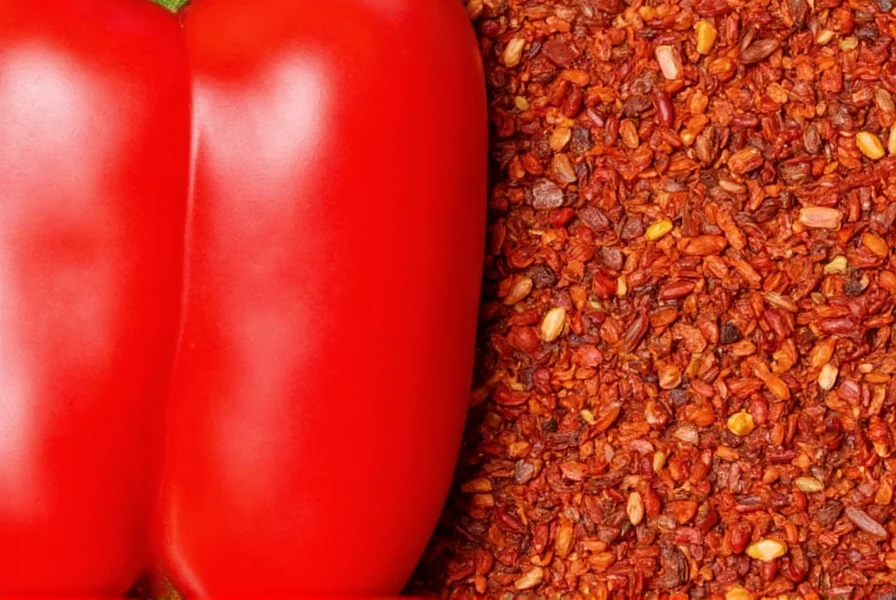When exploring the world of red pepper varieties, it's essential to distinguish between sweet red bell peppers and spicy red chili peppers. This distinction affects everything from nutritional content to culinary applications and potential substitutions in recipes.
Understanding Red Pepper Types
The term "red pepper" creates frequent confusion because it describes two completely different ingredients:
| Red Pepper Type | Scientific Name | Heat Level (Scoville) | Primary Culinary Use |
|---|---|---|---|
| Red Bell Pepper | Capsicum annuum | 0 SHU (sweet) | Fresh salads, roasting, stuffing |
| Crushed Red Pepper | Capsicum frutescens | 30,000-50,000 SHU | Spicing pasta, pizza, sauces |
Red bell peppers are simply green bell peppers allowed to mature fully on the vine. This extended ripening process increases their sugar content while developing higher concentrations of beneficial compounds. In contrast, crushed red pepper typically contains a blend of dried cayenne, jalapeño, and other hot chili varieties.

Nutritional Benefits of Red Bell Peppers
Among all bell pepper colors, red varieties offer the most impressive nutritional profile. A single medium red bell pepper (119g) provides:
- 158% of daily vitamin C requirements
- 93% of daily vitamin A needs
- Significant amounts of vitamin B6, potassium, and folate
- Approximately 37 calories
The extended ripening process that creates red bell peppers dramatically increases their antioxidant content compared to green varieties. Specifically, red peppers contain nearly eleven times more beta-carotene and 1.5 times more vitamin C than their green counterparts. These compounds contribute to improved eye health, stronger immune function, and reduced inflammation.
Culinary Applications and Cooking Tips
Understanding how to properly use red pepper in cooking can transform your dishes. Red bell peppers work exceptionally well in applications where sweetness and vibrant color matter:
- Raw applications: Slice into salads, crudité platters, or sandwiches where their natural sweetness shines
- Roasting: High-heat roasting caramelizes natural sugars, creating depth of flavor for sauces and spreads
- Stir-frying: Add during the last 3-5 minutes of cooking to preserve texture and color
- Stuffing: Their sturdy structure makes them ideal containers for rice, meat, or grain fillings
When working with spicy red pepper flakes, remember that heat intensity varies significantly between brands. Start with smaller amounts (⅛ teaspoon) and adjust to taste, as the capsaicin compounds responsible for heat distribute unevenly in flakes.
Selecting and Storing Red Peppers
For optimal freshness and flavor when choosing fresh red peppers:
- Select firm peppers with smooth, glossy skin and deep color
- Avoid specimens with wrinkles, soft spots, or dull coloring
- Heavier peppers typically contain more flesh and less air space
- Store unwashed in the crisper drawer for up to 2 weeks
Dried red pepper products should be stored in airtight containers away from light and heat. Properly stored, they maintain potency for 6-12 months. Test older spices by rubbing a small amount between fingers—if the aroma is weak, it's time for replacement.
Common Substitutions and Equivalents
Understanding red pepper substitutions prevents recipe failures when your preferred variety isn't available:
- For red bell pepper: Orange or yellow bell peppers provide similar sweetness with slightly different flavor notes
- For crushed red pepper: Cayenne powder (use ½ amount) or fresh chopped serrano peppers (1:3 ratio)
- When substituting dried for fresh: 1 teaspoon red pepper flakes ≈ 1 fresh medium-hot chili
Remember that sweet and spicy red peppers are not interchangeable in recipes. Using red bell pepper when a recipe calls for red pepper flakes will eliminate heat entirely, while substituting spicy flakes for sweet bell peppers will dramatically alter flavor profiles.
Addressing Common Misconceptions
Several persistent myths surround red peppers:
- Myth: All red peppers are spicy
Fact: Red bell peppers contain zero capsaicin and are completely sweet - Myth: Red peppers are a different plant species than green peppers
Fact: They're the same plant allowed to ripen longer - Myth: The heat in red pepper flakes comes from seeds
Fact: Capsaicin concentrates in the white pith, not seeds
Understanding these distinctions helps home cooks make informed decisions when following recipes or creating their own culinary masterpieces with red pepper varieties.
What's the difference between red bell pepper and red pepper flakes?
Red bell peppers are sweet, fully ripened bell peppers with zero heat, while red pepper flakes are made from dried hot chili peppers like cayenne. They come from different pepper varieties and serve completely different culinary purposes—one adds sweetness and color, the other adds heat.
Can I substitute red bell pepper for red pepper in recipes?
No, these are not interchangeable. Red bell pepper provides sweetness and moisture, while red pepper (flakes) adds heat. Substituting one for the other will dramatically alter your dish's flavor profile and heat level.
Why are red bell peppers more expensive than green ones?
Red bell peppers require additional growing time (2-3 weeks longer) to ripen from green to red on the vine. This extended time increases production costs and reduces overall yield per plant, making them more expensive than green peppers.
How can I reduce the heat from red pepper flakes in a dish?
Add dairy products like yogurt or sour cream, which contain casein that binds to capsaicin. Acidic ingredients like lemon juice or vinegar can also help neutralize heat. Adding more non-spicy ingredients to dilute the dish works for soups and stews.
Do red peppers lose nutrients when cooked?
Some nutrients like vitamin C decrease with heat, but cooking actually increases the availability of certain antioxidants like carotenoids. Roasting or stir-frying preserves more nutrients than boiling. For maximum nutritional benefit, use a combination of raw and lightly cooked red peppers.











 浙公网安备
33010002000092号
浙公网安备
33010002000092号 浙B2-20120091-4
浙B2-20120091-4